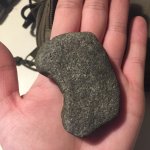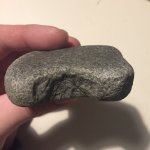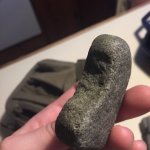Wandermore91
Jr. Member
Upvote
0
I just took some photos of some of better Hammerstones and Stone Tools to show someone so I'll share them here as well. As Charl said, the amount of Stone Tools you find is very small compared to Flint pieces.
I have collected for 53 years now, and though I do have quite a few Stone Tools, I have about 10 to 15 times more Flint pieces.
Now, I would like to simply make a suggestion. I notice that, for the most part, in your threads, you are picking up and looking at large rocks, and stones that cannot be knapped or flaked. Yet, for all of us, 95-99% of all the artifacts we find will be flaked stone artifacts. Things like points, knives, scrapers, drills, flake tools, etc. Artifacts made of the toolstones from our locality or region that could be knapped or flaked into the type of tools mentioned. Yet, many beginners seem to spend a lot of time looking at big rocks and for big tools. You did find a nice grooved weight, and hammerstones are common enough, actually, once you learn to recognize them.
That said, only a tiny % of the artifacts any of us find will be large hardstone tools, such as axes, gouges, adzes, pestles, celts, etc., etc., etc. The overwhelming % will be smaller flaked artifacts like those I mentioned, made, not of hardstone, but stones that can be knapped. In your first thread, you showed us quartz and argillite artifacts you found. What you really want to do, therefore, is learn to recognize the types of knappable toolstones found in your region, and find the type of artifacts made of those toolstones. In your region, that means learning to recognize, in agricultural fields, after heavy rains, and with permission, or on shorelines, toolstones such as quartz, argillite, rhyolite, quartzite, hornfels, chert or flint, jasper, and a few others.
You are far better off looking for what constitutes 95+% of what we all find, wherever we hunt: flaked stone artifacts. Eventually, you are likely to find ground stone tools, but they will always constitute a tiny % of your collection. Don't concentrate on large stones at all. Not at first, anyway. Keep your eye out, sure, but focus on what you are far more likely to find, because they are far more common. Flaked stone artifacts.
Here are four site frames. Meaning these are frames, each from a particular site, from RI. All the materials I mentioned above, the varieties of toolstones in other words, can be seen in these frames. What you need to do is familiarize yourself with the type of knappable material used in your region, and then recognize those lithics when you see them on the ground. Don't focus on big rocks at all. Focus on flakes. Where there are flakes, there will be points, etc. These frames show typical New England points, etc. No matter how many years you put in, this will constitute 95+% of what you are going to find....
View attachment 1560582
View attachment 1560583
View attachment 1560584
Well, this last one is not a single site frame, but rather stuff from several sites in RI. But all typical styles and lithic materials found in southern New England:
View attachment 1560585


